|
|
|
Sort Order |
|
|
|
Items / Page
|
|
|
|
|
|
|
| Srl | Item |
| 1 |
ID:
112936
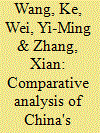

|
|
|
|
|
| Publication |
2012.
|
| Summary/Abstract |
Measuring and improving the energy performance with considering emission constraints is an important issue for China's energy conservation, pollutant emissions reduction and environment protection. This study utilizes several data envelopment analysis (DEA) based models to evaluate the total-factor energy and emission performance of China's 30 regions within a joint production framework of considering desirable and undesirable outputs as well as separated energy and non-energy inputs. DEA window analysis is applied in this study to deal with cross-sectional and time-varying data, so as to measure the performance during the period of 2000-2009. Two treatments for undesirable outputs are combined with DEA models and the associated indicators for simplex energy performance and unified energy and emission performance measurement are proposed and compared. The evaluation results indicate that the treatment of undesirable outputs transformation is more appropriate for China's regional energy and emission performance evaluation because it has stronger discriminating power and can provide more reasonable evaluation results that characterize China's regions. The empirical result shows that east China has the highest and the most balanced energy and emission performance. The energy and emission performance of China remained stable during 2000-2003, decreased slightly during 2004-2006, and has continuously increased since 2007.
|
|
|
|
|
|
|
|
|
|
|
|
|
|
|
|
| 2 |
ID:
090082
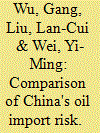

|
|
|
|
|
| Publication |
2009.
|
| Summary/Abstract |
In recent years, the international oil price has fluctuated violently, bringing about huge risk for the international oil trade. In fact, the risk of crude oil and petroleum product imports is different because of the different import origins and prices. Which import risk is lower for China? From the perspective of oil supply security, how should China portfolio crude oil and petroleum product imports to minimize its oil import risk? Using portfolio theory and a diversification index approach, this paper compares and analyzes the supply, price and transport risks of crude oil and petroleum product imports. Our results show that the following: (1) Specific risk (diversification risk) and marine transport risk of China's petroleum product imports are lower than that of crude oil imports. (2) The average rate of return of China's petroleum product imports is higher than that of crude oil imports. Moreover, the average import price variance of petroleum product imports is lower than that of crude oil imports. Thus, the systematic risk (price risk) of petroleum products is lower too. Therefore, from the perspective of oil supply security, China should increase petroleum product imports to decrease its oil import risk.
|
|
|
|
|
|
|
|
|
|
|
|
|
|
|
|
| 3 |
ID:
133228
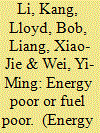

|
|
|
|
|
| Publication |
2014.
|
| Summary/Abstract |
Energy poverty and fuel poverty are descriptors of problems of households' energy consumption, they are both distinct problems and have been addressed by many researchers, organizations and governments. Cross use of the terms of energy poverty and fuel poverty in published papers is common. As an accurate descriptor is the presupposition of research and policy development, especially for those who just started to pay attention to this issue, this paper compares the definitions, research priorities, status quo, and problems of these two concepts, and summarizes the relationship between them. The paper suggests that only when the research targets are households who are living in a cold climate and have difficulty in getting access to electricity or modern cooking facilities, and in supplying indoor heating with appropriate cost, the concepts of energy poverty and fuel poverty have the chance to be broadened and mutually integrated.
|
|
|
|
|
|
|
|
|
|
|
|
|
|
|
|
| 4 |
ID:
094245


|
|
|
|
|
| Publication |
2010.
|
| Summary/Abstract |
This paper attempts to discuss the CO2 emissions embodied in Sino-US international trade using a sector approach. Based on an input-output model established in this study, we quantify the impact of Sino-US international trade on national and global CO2 emissions. Our initial findings reveal that: In 2005, the US reduced 190.13 Mt CO2 emissions through the consumption of imported goods from China, while increasing global CO2 emissions by about 515.25 Mt. Similarly, China reduced 178.62 Mt CO2 emissions through the consumption of US goods, while reducing global CO2 emissions by 129.93 Mt. Sino-US international trade increased global CO2 emissions by 385.32 Mt as a whole, of which the Chemical, Fabricated Metal Products, Non-metallic Mineral Products and Transportation Equipment sectors contributed an 86.71% share. Therefore, we suggest that accelerating the adjustment of China's trade structure and export of US advanced technologies and experience related to clean production and energy efficiency to China as the way to reduce the negative impact of Sino-US trade on national and global CO2 emissions. This behavior should take into account the processing and manufacturing industries as a priority, especially the Chemical, Fabricated Metal Products, Non-metallic Mineral Products and Transportation Equipment sectors.
|
|
|
|
|
|
|
|
|
|
|
|
|
|
|
|
| 5 |
ID:
092605
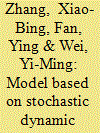

|
|
|
|
|
| Publication |
2009.
|
| Summary/Abstract |
China's Strategic Petroleum Reserve (SPR) is currently being prepared. But how large the optimal stockpile size for China should be, what the best acquisition strategies are, how to release the reserve if a disruption occurs, and other related issues still need to be studied in detail. In this paper, we develop a stochastic dynamic programming model based on a total potential cost function of establishing SPRs to evaluate the optimal SPR policy for China. Using this model, empirical results are presented for the optimal size of China's SPR and the best acquisition and drawdown strategies for a few specific cases. The results show that with comprehensive consideration, the optimal SPR size for China is around 320 million barrels. This size is equivalent to about 90 days of net oil import amount in 2006 and should be reached in the year 2017, three years earlier than the national goal, which implies that the need for China to fill the SPR is probably more pressing; the best stockpile release action in a disruption is related to the disruption levels and expected continuation probabilities. The information provided by the results will be useful for decision makers.
|
|
|
|
|
|
|
|
|
|
|
|
|
|
|
|
| 6 |
ID:
111444
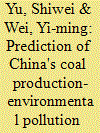

|
|
|
|
|
| Publication |
2012.
|
| Summary/Abstract |
This paper proposes a hybrid model based on genetic algorithm (GA) and system dynamics (SD) for coal production-environmental pollution load in China. GA has been utilized in the optimization of the parameters of the SD model to reduce implementation subjectivity. The chain of "Economic development-coal demand-coal production-environmental pollution load" of China in 2030 was predicted, and scenarios were analyzed. Results show that: (1) GA performs well in optimizing the parameters of the SD model objectively and in simulating the historical data; (2) The demand for coal energy continuously increases, although the coal intensity has actually decreased because of China's persistent economic development. Furthermore, instead of reaching a turning point by 2030, the environmental pollution load continuously increases each year even under the scenario where coal intensity decreased by 20% and investment in pollution abatement increased by 20%; (3) For abating the amount of "three types of wastes", reducing the coal intensity is more effective than reducing the polluted production per tonne of coal and increasing investment in pollution control.
|
|
|
|
|
|
|
|
|
|
|
|
|
|
|
|
| 7 |
ID:
128047
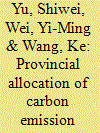

|
|
|
|
|
| Publication |
2014.
|
| Summary/Abstract |
An approach to determine carbon emission reduction target allocation based on the particle swarm optimization (PSO) algorithm, fuzzy c-means (FCM) clustering algorithm, and Shapley decomposition (PSO-FCM-Shapley) is proposed in this study. The method decomposes total carbon emissions into an interaction result of four components (i.e., emissions from primary, secondary, and tertiary industries, and from residential areas) which composed totally by 13 macro influential factors according to the KAYA identity. Then, 30 provinces in China are clustered into four classes according to the influential factors via the PSO-FCM clustering method. The key factors that determine emission growth in the provinces representing each cluster are investigated by applying Shapley value decomposition. Finally, based on guaranteed survival emissions, the reduction burden is allocated by controlling the key factors that decelerate CO2 emission growth rate according to the present economic development level, energy endowments, living standards, and the emission intensity of each province. A case study of the allocation of CO2 intensity reduction targets in China by 2020 is then conducted via the proposed method. The per capita added value of the secondary industry is the primary factor for the increasing carbon emissions in provinces. Therefore, China should limit the growth rate of its secondary industry to mitigate emission growth. Provinces with high cardinality of emissions have to shoulder the largest reduction, whereas provinces with low emission intensity met the minimum requirements for emission in 2010. Fifteen provinces are expected to exceed the national average decrease rates from 2011 to 2020.
|
|
|
|
|
|
|
|
|
|
|
|
|
|
|
|
| 8 |
ID:
111426
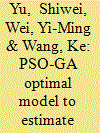

|
|
|
|
|
| Publication |
2012.
|
| Summary/Abstract |
To improve estimation efficiency for future projections, the present study has proposed a hybrid algorithm, Particle Swarm Optimization and Genetic Algorithm optimal Energy Demand Estimating (PSO-GA EDE) model, for China. The coefficients of the three forms of the model (linear, exponential, and quadratic) are optimized by PSO-GA using factors, such as GDP, population, economic structure, urbanization rate, and energy consumption structure, that affect demand. Based on 20-year historical data between 1990 and 2009, the simulation results of the proposed model have greater accuracy and reliability than other single optimization methods. Moreover, it can be used with optimal coefficients for the energy demand projections of China. The departure coefficient method is applied to get the weights of the three forms of the model to obtain a combinational prediction. The energy demand of China is going to be 4.79, 4.04, and 4.48 billion tce in 2015, and 6.91, 5.03, and 6.11 billion tce ("standard" tons coal equivalent) in 2020 under three different scenarios. Further, the projection results are compared with other estimating methods.
|
|
|
|
|
|
|
|
|
|
|
|
|
|
|
|
| 9 |
ID:
118837
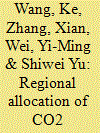

|
|
|
|
|
| Publication |
2013.
|
| Summary/Abstract |
The mitigation efforts of China are increasingly important for meeting global climate target since the rapid economic growth of China has led to an increasing share in the world's total CO2 emissions. This paper sets out to explore the approach for realizing China's national mitigation targets submitted to the UNFCCC as part of the Copenhagen Accord; that is, to reduce the intensity of CO2 emissions per unit of GDP by 40-45% by 2020, as well as reducing the energy intensity and increasing the share of non-fossil fuel consumption, through regional allocation of emission allowance over China's provinces. Since the realization of China's mitigation target essentially represents a total amount emission allowance allocation problem, an improved zero sum gains data envelopment analysis optimization model, which could deal with the constant total amount resources allocation, is proposed in this study. By utilizing this model and based on several scenarios of China's economic growth, CO2 emissions, and energy consumption, a new efficient emission allowance allocation scheme on provincial level for China by 2020 is proposed. The allocation results indicate that different provinces have to shoulder different mitigation burdens in terms of emission intensity reduction, energy intensity reduction, and share of non-fossil fuels increase.
|
|
|
|
|
|
|
|
|
|
|
|
|
|
|
|
| 10 |
ID:
125441


|
|
|
|
|
| Publication |
2013.
|
| Summary/Abstract |
Carbon capture, utilization and storage (CCUS) technology will likely become an important approach to reduce carbon dioxide (CO2) emissions and optimize the structure of energy consumption in China in the future. In order to provide guidance and recommendations for CCUS Research, Development and Demonstration in China, a high level stakeholder workshop was held in Chongqing in June 2011 to develop a technology roadmap for the development of CCUS technology. This roadmap outlines the overall vision to provide technically viable and economically affordable technological options to combat climate change and facilitate socio-economic development in China. Based on this vision, milestone goals from 2010 to 2030 are set out in accordance with the technology development environment and current status in China. This study identifies the critical technologies in capture, transport, utilization and storage of CO2 and proposes technical priorities in the different stages of each technical aspect by evaluating indices such as the objective contribution rate and technical maturity, and gives recommendations on deployment of full-chain CCUS demonstration projects. Policies which would support CCUS are also suggested in this study.
|
|
|
|
|
|
|
|
|
|
|
|
|
|
|
|
|
|
|
|
|